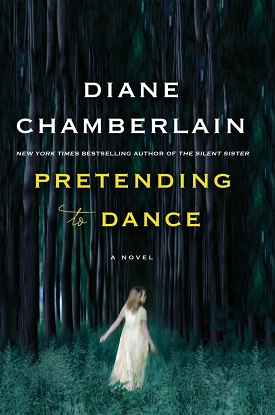 Synopsis:
Synopsis:
Molly Arnette is good at keeping secrets and not just because, as an attorney, it is a job requirement. She has been keeping secrets for most of her life. And now that she and her husband, Aidan, have decided to adopt a baby, Molly fears that the secrets she has kept from him about her childhood in North Carolina, her relationships with her family members, and the circumstances surrounding her father’s death will be revealed, thereby destroying her hope of becoming a mother, as well as her marriage.
Molly left North Carolina twenty years ago. Devastated, feeling betrayed by those she loved, and determined to escape her pain, she settled in San Diego. She also manufactured a family history that bore no resemblance to the truth. But now, contemplating adoption, she wants peace, resolution, and to create a healthy, loving family with Aidan. But will that be possible when Molly discovers that what she has always believed to be true might not be, after all.
Review:

Best-selling author Diane Chamberlain holds bachelor’s and master’s degrees in social work from San Diego State University, and worked at youth counseling agencies before establishing a private psychotherapy practice in Alexandria, Virginia, specializing in adolescents. That background informs, and lends authenticity and believability to her latest novel.
Pretending to Dance focuses upon Molly Arnette’s story, told from her perspective as a thirty-eight-year-old attorney living in San Diego in 2014 and at the age of fourteen. Molly grew up on Morrison Ridge in Swannanoa, North Carolina, one hundred rural acres owned by her family. Her grandmother lived in the main residence, while Molly resided with her parents, Nora, a pharmacist, and Graham, a psychologist. Her aunts, uncles, and cousins also had homes on the property. Graham specialized in working with adolescents, employing “pretend therapy,” an approach he summed up as “if you pretend you’re the sort of person you want to be, you will gradually become that person.” Diagnosed with multiple sclerosis prior to her parents’ marriage, Graham’s condition deteriorated over the years until, by 1990, he was wheelchair-bound and had lost the use of his hands, at which point his caretaker, Russell, moved in with the Arnettes.
The first-person narrative alternates between Molly’s current struggle to navigate the adoption process and, along with Aidan, negotiate the parameters of an “open” adoption as she worries that the carefully constructed fictional background she supplied Aidan will be revealed, their application denied, and her dream of being a mother permanently thwarted. She also fears Aidan’s reaction if he learns her claim of having no surviving family members is untrue. Molly feels accepted and safe with Aidan, genuinely wants her marriage to succeed, and longs to be a mother. But her relationship with Aidan is like the proverbial house of cards — poised to collapse if Aidan discovers and cannot forgive her lies.
 Molly had a happy, love-filled, if confusing, childhood back in North Carolina where she was devoted to and doted upon by her father. Her mother, Nora, was, in Molly’s estimation, more aloof, reserved, and, more often than not, the disciplinarian. Molly describes how sheltered she was and her burgeoning friendship with a “wild” girl who encouraged her to disobey and deceive her parents on what would ironically turn out to be a fateful night that changed her families’ lives forever. The prequel, Chamberlain’s short story The Dance Begins, charmingly establishes not only the setting, but, more importantly, the unbreakable bond between Molly and Graham. Because it adds context to Pretending to Dance, I highly recommend reading the short story first.
Molly had a happy, love-filled, if confusing, childhood back in North Carolina where she was devoted to and doted upon by her father. Her mother, Nora, was, in Molly’s estimation, more aloof, reserved, and, more often than not, the disciplinarian. Molly describes how sheltered she was and her burgeoning friendship with a “wild” girl who encouraged her to disobey and deceive her parents on what would ironically turn out to be a fateful night that changed her families’ lives forever. The prequel, Chamberlain’s short story The Dance Begins, charmingly establishes not only the setting, but, more importantly, the unbreakable bond between Molly and Graham. Because it adds context to Pretending to Dance, I highly recommend reading the short story first.
Molly’s recollection of that tumultuous time is, for the most part, credible and identifiable. She compellingly describes the time on the cusp of adulthood that is full of exploration, questioning, testing, and revelations that ultimately shape who we become. But for Molly, that natural coming-of-age took place against the backdrop of her father’s debilitating illness and her family’s efforts to shield her from its realities. The toll his condition was taking not just on him, but on those who loved him, was deliberately concealed from her until that one tragic night. Thereafter, Molly’s life was punctuated by loss, grief, anger, and decisions founded upon faulty conclusions. Until, that is, she is forced to confront her past in order to move forward and create the type of family she has always wanted.
Treasure your family, Molly. Yes, they are a complex mix of personalities but they all love you. Eventually you’ll come to realize that everyone comes from a dysfunctional family. There is no other kind.”~ Graham Arnette in Pretending to Dance
Chamberlain explores family themes with her signature deftness through character and plot development, inserting clues at strategically-paced intervals that pique reader curiosity. Each character is empathetic in their own right. As an adult to become a parent, Molly must learn if she has the capacity to understand the struggles and motivations that fueled decisions made by the adults in her life so many years ago. In the process, she must finally confront her evolving emotions. Molly acknowledges that she chose a career in law because it seemed as far from pretending as she could get. “Law was all about harsh reality, I thought. All about facts and truth and justice. I was wrong. Practicing law lifts pretense to an art form. I pretend every day that my clients are in the right, that I am not twisting the truth to win their cases. I’ve loved the challenge and I love when I can help good people triumph, but I know the truth about myself and my work: I am a pretender of the first order. And I’m a little tired of it.” At the heart of the story lies the question of whether she has the courage to speak the truth, accept, and forgive in order to stop pretending — in her personal life, as well as professionally.
Her parents, Nora and Graham, are even more sympathetic. Graham’s heartbreaking circumstances require strength and unthinkable choices for all concerned. Ultimately, the story proves her thesis, articulated through the character of Graham: “It’s hard to move on if you don’t forgive. It’s like trying to dance with a lead weight on your shoulders. The anger can weigh you down forever.”
Pretending to Dance is a timely, gripping, and thought-provoking exploration of what it means to be part of a family, put others’ needs ahead of one’s own, and accept and forgive what appear, at first blush, to be unforgivable acts in order to create peace and happiness for oneself.








Comments are closed.